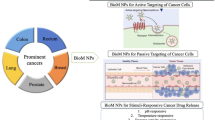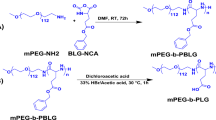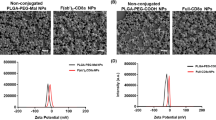Abstract
Aliphatic polyesters have been widely explored for biomedical applications (e.g., drug delivery systems, biomedical devices, and tissue engineering). Recently, polyesters have been used in nanoparticle formulations for the controlled release of monoclonal antibodies (mAbs) for the enhanced efficacy of antibody-based therapy. Polyester-based nanoparticles for mAb delivery provide decreased antibody dosage, increased antibody stability and protection and longer therapeutic action, ultimately translating to an increased therapeutic index. Additionally, nanoencapsulation holds the potential for the selective cellular recognition and internalization of mAbs, in the disease context when intracellular organelles and molecules (e.g., enzymes, transcription factors and oncogenic proteins) are the preferred target. We present here a detailed method to prepare mAb-loaded polyester-based nanoparticles and the various techniques to characterize the resulting nanoparticles and mAb structure. Finally, we highlight different biological approaches to assess the in vitro bioactivity of the antibody upon nanoparticle release.
Access this chapter
Tax calculation will be finalised at checkout
Purchases are for personal use only
Similar content being viewed by others
References
Scott AM, Wolchok JD, Old LJ (2012) Antibody therapy of cancer. Nat Rev Cancer 12(4):278–287
Li J, Zhu Z (2010) Research and development of next generation of antibody-based therapeutics. Acta Pharmacol Sin 31(9):1198–1207
Ecker DM, Jones SD, Levine HL (2015) The therapeutic monoclonal antibody market. mAbs 7(1):9–14
Chames P, Van Regenmortel M, Weiss E, Baty D (2009) Therapeutic antibodies: successes, limitations and hopes for the future. Br J Pharmacol 157(2):220–233
Modjtahedi H, Ali S, Essapen S (2012) Therapeutic application of monoclonal antibodies in cancer: advances and challenges. Br Med Bull 104(1):41–59
Beckman RA, Weiner LM, Davis HM (2007) Antibody constructs in cancer therapy: protein engineering strategies to improve exposure in solid tumors. Cancer 109(2):170–179
Thurber GM, Schmidt MM, Wittrup KD (2008) Antibody tumor penetration: transport opposed by systemic and antigen-mediated clearance. Adv Drug Deliv Rev 60(12):1421
Samaranayake H, Wirth T, Schenkwein D, Raty JK, Yla-Herttuala S (2009) Challenges in monoclonal antibody-based therapies. Ann Med 41(5):322–331
Arruebo M, Valladares M, González-Fernández Á (2009) Antibody-conjugated nanoparticles for biomedical applications. J Nanomater 2009:24
Ravikumar M (2016) Handbook of polyester drug delivery systems. Pan Stanford, USA
Marin E, Briceño MI, Caballero-George C (2013) Critical evaluation of biodegradable polymers used in nanodrugs. Int J Nanomedicine 8:3071–3091
Varshochian R, Jeddi-Tehrani M, Mahmoudi AR, Khoshayand MR, Atyabi F, Sabzevari A, Esfahani MR, Dinarvand R (2013) The protective effect of albumin on bevacizumab activity and stability in PLGA nanoparticles intended for retinal and choroidal neovascularization treatments. Eur J Pharm Sci 50(3–4):341–352
Son S, Lee WR, Joung YK, Kwon MH, Kim YS, Park KD (2009) Optimized stability retention of a monoclonal antibody in the PLGA nanoparticles. Int J Pharm 368(1–2):178–185
Grainger DW (2004) Controlled-release and local delivery of therapeutic antibodies. Expert Opin Biol Ther 4(7):1029–1044
Yadav SC, Kumari A, Yadav R (2011) Development of peptide and protein nanotherapeutics by nanoencapsulation and nanobioconjugation. Peptides 32(1):173–187
Cardoso MM, Peca IN, Roque AC (2012) Antibody-conjugated nanoparticles for therapeutic applications. Curr Med Chem 19(19):3103–3127
Srinivasan AR, Lakshmikuttyamma A, Shoyele SA (2013) Investigation of the stability and cellular uptake of self-associated monoclonal antibody (MAb) nanoparticles by non-small lung cancer cells. Mol Pharm 10(9):3275–3284
Pinto Reis C, Neufeld RJ, Ribeiro AJ, Veiga F (2006) Nanoencapsulation: I. Methods for preparation of drug-loaded polymeric nanoparticles. Nanomedicine 2(1):8–21
Li F, Hurley B, Liu Y, Leonard B, Griffith M (2012) Controlled release of bevacizumab through nanospheres for extended treatment of age-related macular degeneration. Open Ophthalmol J 6:54–58
Gdowski A, Ranjan A, Mukerjee A, Vishwanatha J (2015) Development of biodegradable nanocarriers loaded with a monoclonal antibody. Int J Mol Sci 16(2):3990–3995
Almeida A, Souto E (2007) Solid lipid nanoparticles as a drug delivery system for peptides and proteins. Adv Drug Deliv Rev 59(6):478–490
Shoyele SA, Slowey A (2006) Prospects of formulating proteins/peptides as aerosols for pulmonary drug delivery. Int J Pharm 314(1):1–8
Fonte P, Soares S, Sousa F, Costa A, Seabra V, Reis S, Sarmento B (2014) Stability study perspective of the effect of freeze-drying using cryoprotectants on the structure of insulin loaded into PLGA nanoparticles. Biomacromolecules 15(10):3753–3765
Hawe A, Kasper JC, Friess W, Jiskoot W (2009) Structural properties of monoclonal antibody aggregates induced by freeze-thawing and thermal stress. Eur J Pharm Sci 38(2):79–87
Sarmento B, Ferreira DC, Jorgensen L, van de Weert M (2007) Probing insulin’s secondary structure after entrapment into alginate/chitosan nanoparticles. Eur J Pharm Biopharm 65(1):10–17
Greenfield NJ (2006) Using circular dichroism spectra to estimate protein secondary structure. Nat Protoc 1(6):2876–2890
Chelius D, Ruf P, Plöscher M, Liedtke R, Gansberger E, Hess J, Wasiliu M, Lindhofer H (2010) Structural and functional characterization of the trifunctional antibody catumaxomab. mAbs 2(3):309–319
Garidel P, Hegyi M, Bassarab S, Weichel M (2008) A rapid, sensitive and economical assessment of monoclonal antibody conformational stability by intrinsic tryptophan fluorescence spectroscopy. Biotechnol J 3(9–10):1201–1211
Oliveira Silva C, Petersen SB, Pinto Reis C, Rijo P, Molpeceres J, Vorum H, Neves-Petersen MT (2015) Lysozyme photochemistry as a function of temperature. The protective effect of nanoparticles on lysozyme photostability. PLoS One 10(12):e0144454
Ellis LM, Hicklin DJ (2008) VEGF-targeted therapy: mechanisms of anti-tumour activity. Nat Rev Cancer 8(8):579–591
Wang Y, Fei D, Vanderlaan M, Song A (2004) Biological activity of bevacizumab, a humanized anti-VEGF antibody in vitro. Angiogenesis 7(4):335–345
Goel HL, Mercurio AM (2013) VEGF targets the tumour cell. Nat Rev Cancer 13(12):871–882
Ferrara N, Hillan KJ, Gerber H-P, Novotny W (2004) Discovery and development of bevacizumab, an anti-VEGF antibody for treating cancer. Nat Rev Drug Discov 3(5):391–400
Carneiro A, Falcao M, Azevedo I, Falcao Reis F, Soares R (2009) Multiple effects of bevacizumab in angiogenesis: implications for its use in age-related macular degeneration. Acta Ophthalmol 87(5):517–523
Stockert JC, Blázquez-Castro A, Cañete M, Horobin RW, Villanueva Á (2012) MTT assay for cell viability: intracellular localization of the formazan product is in lipid droplets. Acta Histochem 114(8):785–796
Cell Proliferation ELISA, BrdU (colorimetric). Roche Diagnostics, Mannheim, Germany. http://www.sigmaaldrich.com/catalog/product/roche/11647229001?lang=en®ion=NO. Accessed 10 July 2016
Shi K, Cui F, Yamamoto H, Kawashima Y (2009) Optimized formulation of high-payload PLGA nanoparticles containing insulin–lauryl sulfate complex. Drug Dev Ind Pharm 35(2):177–184
Cohen-Sela E, Chorny M, Koroukhov N, Danenberg HD, Golomb G (2009) A new double emulsion solvent diffusion technique for encapsulating hydrophilic molecules in PLGA nanoparticles. J Control Release 133(2):90–95
Kelly SM, Price NC (2000) The use of circular dichroism in the investigation of protein structure and function. Curr Protein Pept Sci 1(4):349–384
Tetin SY, Linthicum DS (1996) Circular dichroism spectroscopy of monoclonal antibodies that bind a superpotent guanidinium sweetener ligand. Biochemistry 35(4):1258–1264
Joshi V, Shivach T, Yadav N, Rathore AS (2014) Circular dichroism spectroscopy as a tool for monitoring aggregation in monoclonal antibody therapeutics. Anal Chem 86(23):11606–11613
Acknowledgments
Flávia Sousa would like to thank to Fundação para a Ciência e a Tecnologia (FCT), Portugal for financial support (Grant SFRH/BD/112201/2015). Patrick J. Kennedy gratefully acknowledges the BiotechHealth Programme (Doctoral Programme in Cellular and Molecular Biotechnology Applied to Health Sciences) and FCT for financial support (SFRH/BD/99036/2013) and beyond. This work was also financed by FEDER—Fundo Europeu de Desenvolvimento Regional funds through the COMPETE 2020—Operational Programme for Competitiveness and Internationalisation (POCI), Portugal 2020, and by Portuguese funds through FCT—Fundação para a Ciência e a Tecnologia/Ministério da Ciência, Tecnologia e Inovação in the framework of the projects “Institute for Research and Innovation in Health Sciences” (POCI-01-0145-FEDER-007274) and UID/BIM/04293/2013.
Author information
Authors and Affiliations
Corresponding author
Editor information
Editors and Affiliations
Rights and permissions
Copyright information
© 2018 Springer Science+Business Media LLC
About this protocol
Cite this protocol
Sousa, F., Fonte, P., Cruz, A., Kennedy, P.J., Pinto, I.M., Sarmento, B. (2018). Polyester-Based Nanoparticles for the Encapsulation of Monoclonal Antibodies. In: Picanço-Castro, V., Swiech, K. (eds) Recombinant Glycoprotein Production. Methods in Molecular Biology, vol 1674. Humana Press, New York, NY. https://doi.org/10.1007/978-1-4939-7312-5_20
Download citation
DOI: https://doi.org/10.1007/978-1-4939-7312-5_20
Published:
Publisher Name: Humana Press, New York, NY
Print ISBN: 978-1-4939-7311-8
Online ISBN: 978-1-4939-7312-5
eBook Packages: Springer Protocols




